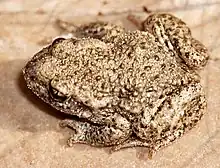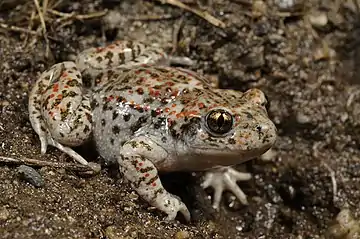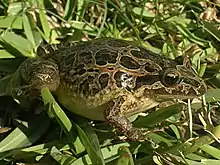Alytidae
The Alytidae are a family of primitive frogs.[2][3][4][5] Their common name is painted frogs[2] or midwife toads.[4] Most are endemic to Europe, but three species occur in northwest Africa, and a species formerly thought to be extinct is found in Israel.
| Alytidae Temporal range: | |
|---|---|
 | |
| Alytes obstetricans | |
| Scientific classification | |
| Domain: | Eukaryota |
| Kingdom: | Animalia |
| Phylum: | Chordata |
| Class: | Amphibia |
| Order: | Anura |
| Suborder: | Archaeobatrachia |
| Family: | Alytidae Fitzinger, 1843 |
| Genera | |
|
Genus Alytes | |
 | |
| Distribution of Discoglossidae (in black) | |
| Synonyms | |
|
Discoglossidae Günther, 1859 | |
This family is also known as Discoglossidae, but the older name Alytidae has priority and is now recognized by major reference works.[2][3][4][5] Some researchers, though, suggest that Alytes and Discoglossus are different enough to be treated as belonging to separate families, implying resurrection of the Discoglossidae.[2] The term "discoglossid" has also been used to refer to many primitive fossil frogs that share plesiomorphic (ancestral) similities to alytids, but that are probably not closely related.[6]
Genera and species
The family contains three extant genera, Alytes, Discoglossus, and Latonia. The first is somewhat toad-like and can often be found on land. The second is smoother and more frog-like, preferring the water.[7] The third genus was until recently considered extinct, and is represented by the recently rediscovered Hula painted frog. All of the species have pond-dwelling tadpoles.
The genera Bombina and Barbourula also used to be under this family, but have now been moved to the Bombinatoridae.[8]
Extant genera
| Image | Genus | Species |
|---|---|---|
 |
Alytes Wagler, 1830 |
|
_jeannaea.jpg.webp) |
Discoglossus Otth, 1837 |
|
 |
Latonia Meyer, 1843 |
|
Extinct genera
Family Alytidae
- Genus †Enneabatrachus (prehistoric)[1]
- †Enneabatrachus hechti[1]
- Genus †Aralobatrachus (prehistoric)
- †Aralobatrachus robustus
- Genus †Callobatrachus (prehistoric)
- †Callobatrachus sanyanensis
- Genus †Bakonybatrachus (prehistoric)
- †Bakonybatrachus fedori
- Genus †Eodiscoglossus (prehistoric)
- †Eodiscoglossus oxoniensis
- †Eodiscoglossus santonjae
 Iberian midwife toad (Alytes cisternasii)
Iberian midwife toad (Alytes cisternasii) Iberian or Portuguese painted frog (Discoglossus galganoi)
Iberian or Portuguese painted frog (Discoglossus galganoi) Fossil discoglossid from Miocene (†Latonia seyfriedi)
Fossil discoglossid from Miocene (†Latonia seyfriedi)
References
- Foster, J. (2007). "Enneabatrachus hechti" Jurassic West: The Dinosaurs of the Morrison Formation and Their World. Indiana University Press. p. 137.
- Frost, Darrel R. (2014). "Alytidae Fitzinger, 1843". Amphibian Species of the World: an Online Reference. Version 6.0. American Museum of Natural History. Retrieved 12 April 2014.
- "Alytidae Fitzinger, 1843". Integrated Taxonomic Information System.
- "Alytidae". AmphibiaWeb: Information on amphibian biology and conservation. [web application]. Berkeley, California: AmphibiaWeb. 2014. Retrieved 12 April 2014.
- Blackburn, D.C.; Wake, D.B. (2011). "Class Amphibia Gray, 1825. In: Zhang, Z.-Q. (Ed.) Animal biodiversity: An outline of higher-level classification and survey of taxonomic richness" (PDF). Zootaxa. 3148: 39–55.
- Gao, Ke-Qin; Chen, Jianye (2017-03-14). "A New Crown-Group Frog (Amphibia: Anura) from the Early Cretaceous of Northeastern Inner Mongolia, China". American Museum Novitates. 3876 (3876): 1–39. doi:10.1206/3876.1. ISSN 0003-0082.
- Zweifel, Richard G. (1998). Cogger, H.G.; Zweifel, R.G. (eds.). Encyclopedia of Reptiles and Amphibians. San Diego: Academic Press. pp. 85–86. ISBN 0-12-178560-2.
- Frost, Darrel R. (2014). "Bombinatoridae Gray, 1825". Amphibian Species of the World: an Online Reference. Version 6.0. American Museum of Natural History. Retrieved 12 April 2014.
- San Mauro, Diego; Garcia-Paris, Mario; Zardoya, Rafael (December 2004). "Phylogenetic relationships of discoglossid frogs (Amphibia:Anura:Discoglossidae) based on complete mitochondrial genomes and nuclear genes". Gene. 343 (2): 357–366. doi:10.1016/j.gene.2004.10.001. PMID 15588590.
- San Mauro, Diego; Vences, Miguel; Alcobendas, Marina; Zardoya, Rafael; Meyer, Axel (May 2005). "Initial diversification of living amphibians predated the breakup of Pangaea" (PDF). American Naturalist. 165 (5): 590–599. doi:10.1086/429523. JSTOR 10.1086/429523. PMID 15795855.